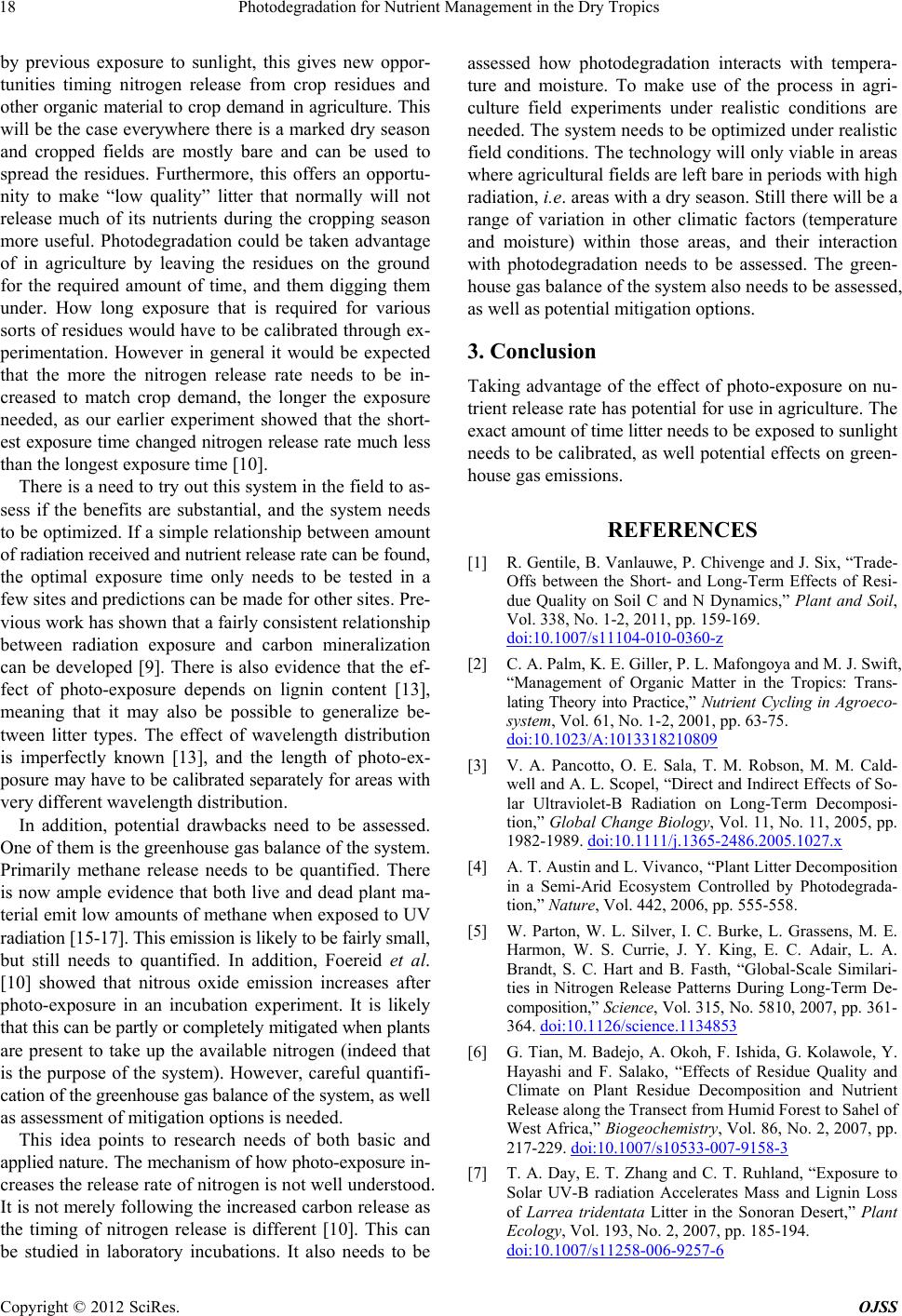
Photodegradation for Nutrient Management in the Dry Tropics
18
by previous exposure to sunlight, this gives new oppor-
tunities timing nitrogen release from crop residues and
other organic material to crop demand in agriculture. This
will be the case everywhere there is a marked dry season
and cropped fields are mostly bare and can be used to
spread the residues. Furthermore, this offers an opportu-
nity to make “low quality” litter that normally will not
release much of its nutrients during the cropping season
more useful. Photodegradation could be taken advantage
of in agriculture by leaving the residues on the ground
for the required amount of time, and them digging them
under. How long exposure that is required for various
sorts of residues would have to be calibrated through ex-
perimentation. However in general it would be expected
that the more the nitrogen release rate needs to be in-
creased to match crop demand, the longer the exposure
needed, as our earlier experiment showed that the short-
est exposure time changed nitrogen release rate much less
than the longest exposure time [10].
There is a need to try out th is system in the field to as-
sess if the benefits are substantial, and the system needs
to be optimized. If a simple relationship between amount
of radiation received and nutrient release rate can be found,
the optimal exposure time only needs to be tested in a
few sites and predictions can be made for other sites. Pre-
vious work has shown that a fairly consistent relationship
between radiation exposure and carbon mineralization
can be developed [9]. There is also evidence that the ef-
fect of photo-exposure depends on lignin content [13],
meaning that it may also be possible to generalize be-
tween litter types. The effect of wavelength distribution
is imperfectly known [13], and the length of photo-ex-
posure may have to be calibrated separately for areas with
very different wavelength distributi on.
In addition, potential drawbacks need to be assessed.
One of them is the greenhouse gas balance of the system.
Primarily methane release needs to be quantified. There
is now ample evidence that both live and dead plant ma-
terial emit low amounts of methane when exposed to UV
radiation [15-17]. This emission is likely to be fairly small,
but still needs to quantified. In addition, Foereid et al.
[10] showed that nitrous oxide emission increases after
photo-exposure in an incubation experiment. It is likely
that th is can be pa rtly or co mplete ly mi tigat ed when plants
are present to take up the available nitrogen (indeed that
is the purpose of the system). However, careful quantifi-
cation of the greenhouse gas balance of the system, as well
as assessment of mitigation options is needed.
This idea points to research needs of both basic and
applied nature. The mechanism of how photo-exposure in-
creases the release rate of nitrogen is not well understood.
It is not merely following the increased carbon release as
the timing of nitrogen release is different [10]. This can
be studied in laboratory incubations. It also needs to be
assessed how photodegradation interacts with tempera-
ture and moisture. To make use of the process in agri-
culture field experiments under realistic conditions are
needed. The system needs to be optimized under realistic
field conditions. Th e technology will only viable in areas
where agricultural fields are left bare in periods with high
radiation, i.e. areas with a dry season. Still there will be a
range of variation in other climatic factors (temperature
and moisture) within those areas, and their interaction
with photodegradation needs to be assessed. The green-
house gas balance of the system also needs to be assessed,
as well as potential mitigation optio ns.
3. Conclusion
Taking advantage of the effect of photo-exposure on nu-
trient release rate has potential for use in agriculture. The
exact amount of time litter needs to be exposed to sunlight
needs to be calibrated, as well potential effects on green-
house gas emissions.
REFERENCES
[1] R. Gentile, B. Vanlauwe, P. Chivenge and J. Six, “Trade-
Offs between the Short- and Long-Term Effects of Resi-
due Quality on Soil C and N Dynamics,” Plant and Soil,
Vol. 338, No. 1-2, 2011, pp. 159-169.
doi:10.1007/s11104-010-0360-z
[2] C. A. Palm, K. E. Giller, P. L. Mafongoya and M. J. Swift,
“Management of Organic Matter in the Tropics: Trans-
lating Theory into Practice,” Nutrient Cycling in Agroeco-
system, Vol. 61, No. 1-2, 2001, pp. 63-75.
doi:10.1023/A:1013318210809
[3] V. A. Pancotto, O. E. Sala, T. M. Robson, M. M. Cald-
well and A. L. Scopel, “Direct and Indirect Effects of So-
lar Ultraviolet-B Radiation on Long-Term Decomposi-
tion,” Global Change Biology, Vol. 11, No. 11, 2005, pp.
1982-1989. doi:10.1111/j.1365-2486.2005.1027.x
[4] A. T. Austin and L. Vivanco, “Plant Litter Decomposition
in a Semi-Arid Ecosystem Controlled by Photodegrada-
tion,” Nature, Vol. 442, 2006, pp. 555-558.
[5] W. Parton, W. L. Silver, I. C. Burke, L. Grassens, M. E.
Harmon, W. S. Currie, J. Y. King, E. C. Adair, L. A.
Brandt, S. C. Hart and B. Fasth, “Global-Scale Similari-
ties in Nitrogen Release Patterns During Long-Term De-
composition,” Sc ience, Vol. 315, No. 5810, 200 7, pp. 361-
364. doi:10.1126/science.1134853
[6] G. Tian, M. Badejo, A. Okoh, F. Ishida, G. Kolawole, Y.
Hayashi and F. Salako, “Effects of Residue Quality and
Climate on Plant Residue Decomposition and Nutrient
Release along the Transect from Humid Forest to Sahel of
West Africa,” Biogeochemistry, Vol. 86, No. 2, 2007, pp.
217-229. doi:10.1007/s10533-007-9158-3
[7] T. A. Day, E. T. Zhang and C. T. Ruhland, “Exposure to
Solar UV-B radiation Accelerates Mass and Lignin Loss
of Larrea tridentata Litter in the Sonoran Desert,” Plant
Ecology, Vol. 193, No. 2, 2007, pp. 185-194.
doi:10.1007/s11258-006-9257-6
Copyright © 2012 SciRes. OJSS